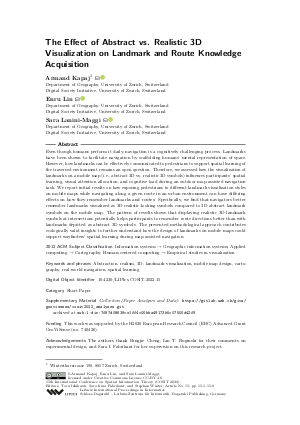The Effect of Abstract vs. Realistic 3D Visualization on Landmark and Route Knowledge Acquisition (Short Paper)
Authors
Armand Kapaj  ,
Enru Lin
,
Enru Lin  ,
Sara Lanini-Maggi
,
Sara Lanini-Maggi 
-
Part of:
Volume:
15th International Conference on Spatial Information Theory (COSIT 2022)
Part of: Series: Leibniz International Proceedings in Informatics (LIPIcs)
Part of: Conference: Conference on Spatial Information Theory (COSIT) - License:
 Creative Commons Attribution 4.0 International license
Creative Commons Attribution 4.0 International license
- Publication Date: 2022-08-22
File

PDF
LIPIcs.COSIT.2022.15.pdf
- Filesize: 3.48 MB
- 8 pages
Document Identifiers
Subject Classification
ACM Subject Classification
- Information systems → Geographic information systems
- Applied computing → Cartography
- Human-centered computing → Empirical studies in visualization
Keywords
- Abstraction
- realism
- 3D
- landmark visualization
- mobile map design
- cartography
- real-world navigation
- spatial learning
Metrics
- Access Statistics
-
Total Accesses (updated on a weekly basis)
0PDF Downloads0Metadata Views
Abstract
Even though humans perform it daily, navigation is a cognitively challenging process. Landmarks have been shown to facilitate navigation by scaffolding humans’ mental representation of space. However, how landmarks can be effectively communicated to pedestrians to support spatial learning of the traversed environment remains an open question. Therefore, we assessed how the visualization of landmarks on a mobile map (i.e., abstract 3D vs. realistic 3D symbols) influences participants’ spatial learning, visual attention allocation, and cognitive load during an outdoor map-assisted navigation task. We report initial results on how exposing pedestrians to different landmark visualization styles on mobile maps while navigating along a given route in an urban environment can have differing effects on how they remember landmarks and routes. Specifically, we find that navigators better remember landmarks visualized as 3D realistic-looking symbols compared to 3D abstract landmark symbols on the mobile map. The pattern of results shows that displaying realistic 3D landmark symbols at intersections potentially helps participants to remember route directions better than with landmarks depicted as abstract 3D symbols. The presented methodological approach contributes ecologically valid insights to further understand how the design of landmarks on mobile maps could support wayfinders' spatial learning during map-assisted navigation.
Cite As Get BibTex
Armand Kapaj, Enru Lin, and Sara Lanini-Maggi. The Effect of Abstract vs. Realistic 3D Visualization on Landmark and Route Knowledge Acquisition (Short Paper). In 15th International Conference on Spatial Information Theory (COSIT 2022). Leibniz International Proceedings in Informatics (LIPIcs), Volume 240, pp. 15:1-15:8, Schloss Dagstuhl – Leibniz-Zentrum für Informatik (2022)
https://doi.org/10.4230/LIPIcs.COSIT.2022.15
BibTex
@InProceedings{kapaj_et_al:LIPIcs.COSIT.2022.15,
author = {Kapaj, Armand and Lin, Enru and Lanini-Maggi, Sara},
title = {{The Effect of Abstract vs. Realistic 3D Visualization on Landmark and Route Knowledge Acquisition}},
booktitle = {15th International Conference on Spatial Information Theory (COSIT 2022)},
pages = {15:1--15:8},
series = {Leibniz International Proceedings in Informatics (LIPIcs)},
ISBN = {978-3-95977-257-0},
ISSN = {1868-8969},
year = {2022},
volume = {240},
editor = {Ishikawa, Toru and Fabrikant, Sara Irina and Winter, Stephan},
publisher = {Schloss Dagstuhl -- Leibniz-Zentrum f{\"u}r Informatik},
address = {Dagstuhl, Germany},
URL = {https://drops.dagstuhl.de/entities/document/10.4230/LIPIcs.COSIT.2022.15},
URN = {urn:nbn:de:0030-drops-169000},
doi = {10.4230/LIPIcs.COSIT.2022.15},
annote = {Keywords: Abstraction, realism, 3D, landmark visualization, mobile map design, cartography, real-world navigation, spatial learning}
}
Author Details
- Department of Geography, University of Zurich, Switzerland
- Digital Society Initiative, University of Zurich, Switzerland
- Department of Geography, University of Zurich, Switzerland
- Digital Society Initiative, University of Zurich, Switzerland
Funding
This work was supported by the H2020 European Research Council (ERC) Advanced Grant GeoViSense (no. 740426).
Acknowledgements
The authors thank Bingjie Cheng, Ian T. Ruginski for their comments on experimental design, and Sara I. Fabrikant for her supervision on this research project.
Supplementary Materials
-
Collection (Paper Analyses and Data)
https://gitlab.uzh.ch/giva/geovisense/cosit2022_analyses.git
browse
 archived version
archived version
References
- H. Couclelis, R.G. Golledge, N. Gale, and W. Tobler. Exploring the anchor-point hypothesis of spatial cognition. Journal of Environmental Psychology, 7(2):99-122, 1987. URL: https://doi.org/10.1016/S0272-4944(87)80020-8.
- B. Elias and V. Paelke. User-Centered Design of Landmark Visualizations. In Map-based Mobile Services. Springer, 2008. URL: https://doi.org/10.1007/978-3-540-37110-6_3.
- A.L. Gardony, T.T. Brunyé, and H.A. Taylor. Navigational Aids and Spatial Memory Impairment: The Role of Divided Attention. Spatial Cognition & Computation, 15(4):246-284, 2015. URL: https://doi.org/10.1080/13875868.2015.1059432.
- T. Ishikawa. Satellite Navigation and Geospatial Awareness: Long-Term Effects of Using Navigation Tools on Wayfinding and Spatial Orientation. The Professional Geographer, 71(2):197-209, 2019. URL: https://doi.org/10.1080/00330124.2018.1479970.
- A. Kapaj, S. Lanini-Maggi, and S. I. Fabrikant. The impact of landmark visualization style on expert wayfinders’ cognitive load during navigation. Abstracts of the ICA, 3:138, 2021. URL: https://doi.org/10.5194/ica-abs-3-138-2021.
- A. Kapaj, S. Lanini-Maggi, and S.I. Fabrikant. The influence of landmark visualization style on expert wayfinders' visual attention during a real-world navigation task. UC Santa Barbara: Center for Spatial Studies, 2021. URL: https://doi.org/10.25436/E2NP44.
- H. Liao, W. Dong, C. Peng, and H. Liu. Exploring differences of visual attention in pedestrian navigation when using 2D maps and 3D geo-browsers. Cartography and Geographic Information Science, 44(6):474-490, 2017. URL: https://doi.org/10.1080/15230406.2016.1174886.
- D.R. Montello. Landmarks are Exaggerated. KI - Künstliche Intelligenz, 31(2):193-197, 2017. URL: https://doi.org/10.1007/s13218-016-0473-5.
- C. Nothegger, S. Winter, and M. Raubal. Selection of Salient Features for Route Directions. Spatial Cognition & Computation, 4(2):113-136, 2004. URL: https://doi.org/10.1207/s15427633scc0402_1.
- M.A. Plesa and W. Cartwright. Evaluating the Effectiveness of Non-Realistic 3D Maps for Navigation with Mobile Devices. In Map-based Mobile Services. Springer, 2008. URL: https://doi.org/10.1007/978-3-540-37110-6_5.
- M. Raubal and S. Winter. Enriching Wayfinding Instructions with Local Landmarks. In Geographic Information Science, 2002. URL: https://doi.org/10.1007/3-540-45799-2_17.
- K-F. Richter and S. Winter. Landmarks. Springer, 2014. URL: https://doi.org/10.1007/978-3-319-05732-3.
- W.P. Tanner and J.A. Swets. A decision-making theory of visual detection. Psychological Review, 61(6):401-409, 1954. URL: https://doi.org/10.1037/h0058700.
- F. Wenczel, L. Hepperle, and R. von Stülpnagel. Gaze behavior during incidental and intentional navigation in an outdoor environment. Spatial Cognition & Computation, 17(1-2):121-142, 2017. URL: https://doi.org/10.1080/13875868.2016.1226838.
- J. Wilkening and S.I. Fabrikant. How Do Decision Time and Realism Affect Map-Based Decision Making? In Spatial Information Theory (COSIT), 2011. URL: https://doi.org/10.1007/978-3-642-23196-4_1.
